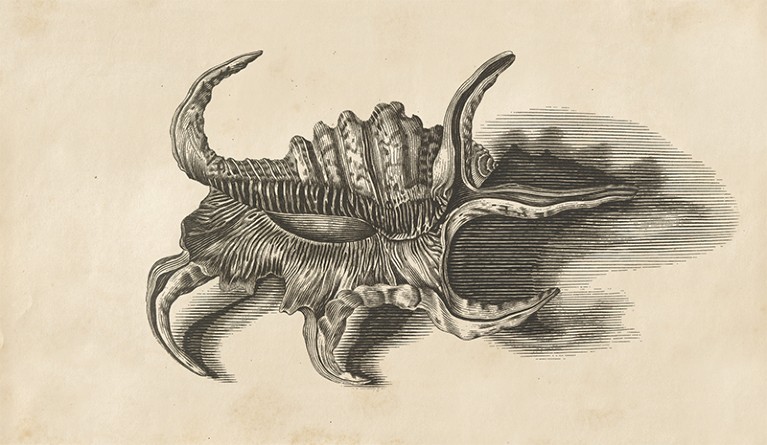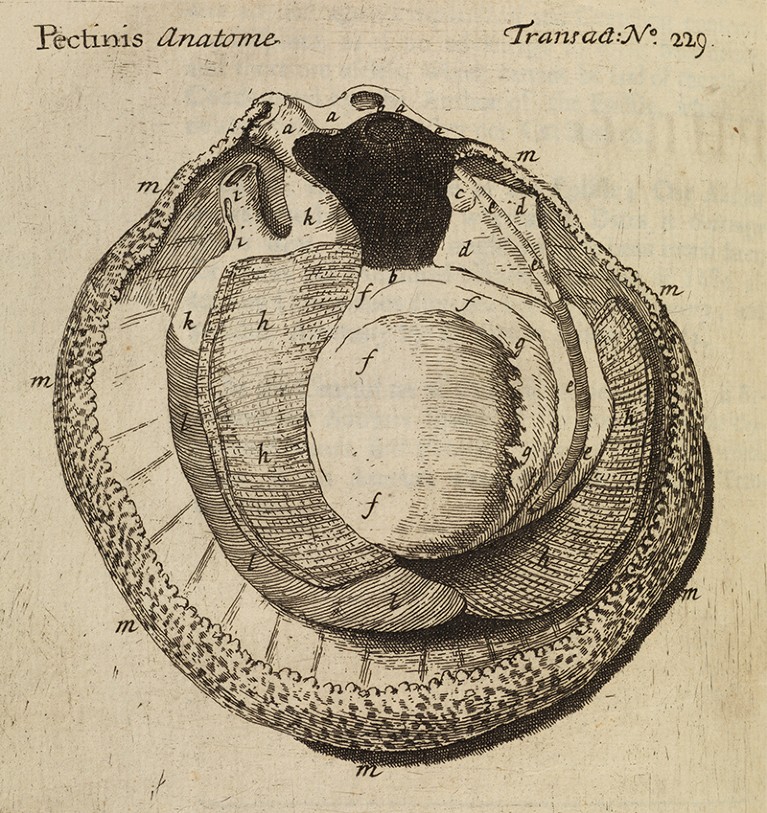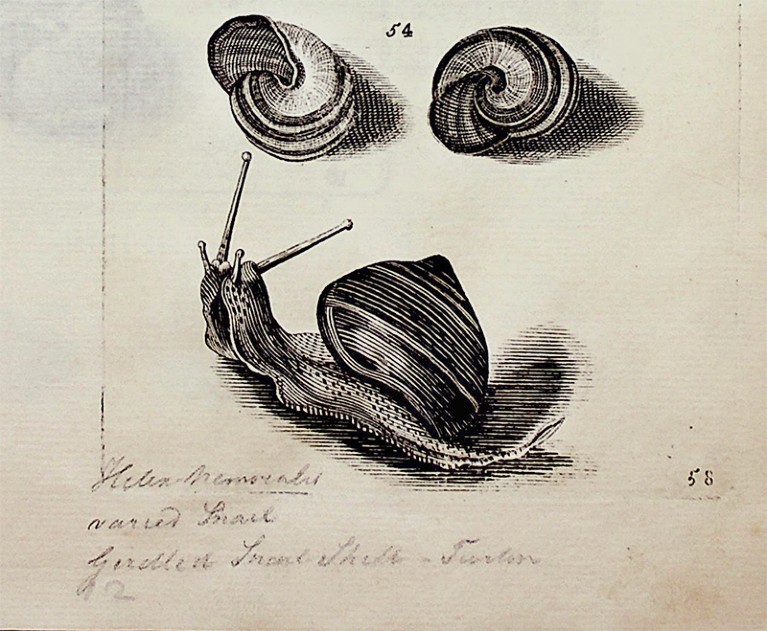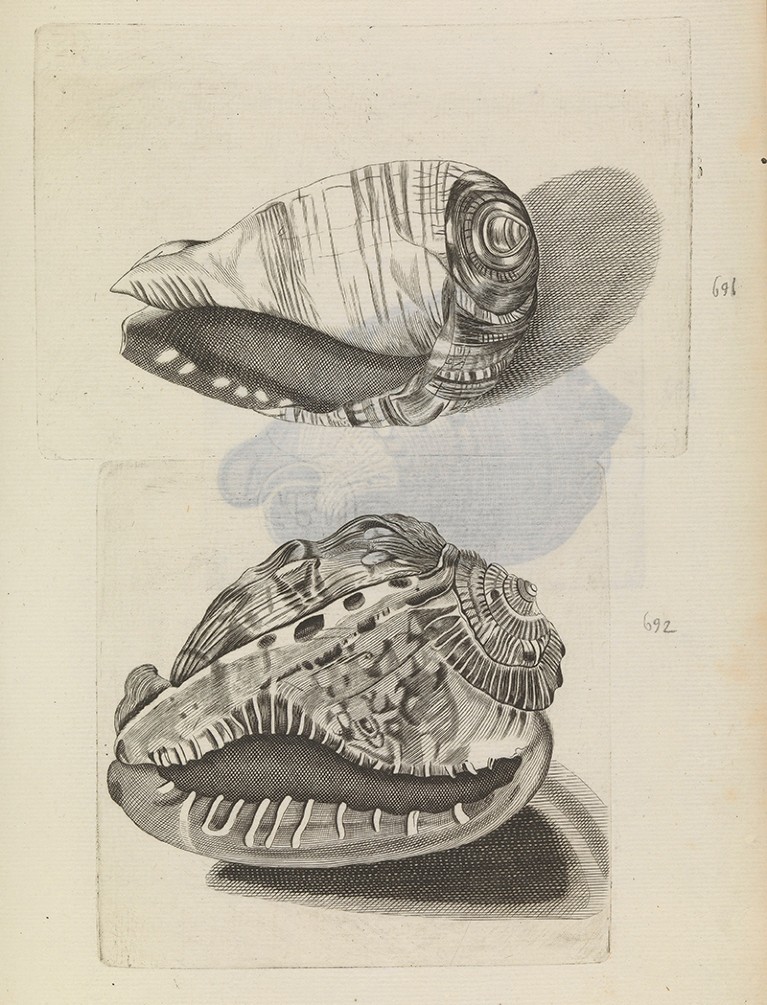
A shell from Historiae Conchyliorum by Martin Lister. The illustrations were engraved by Lister’s daughters, Anna and Susanna.Credit: Wellcome Coll./CC BY 4.0
Martin Lister and his Remarkable Daughters: The Art of Science in the Seventeenth Century Anna Marie Roos Bodleian Library (2018)
Between 1685 and 1692, Martin Lister — a noted British physician and naturalist — published Historiae Conchyliorum, a significant study of molluscs filled with hundreds of beautiful illustrations of all known shells. The illustrators were Lister’s daughters Anna and Susanna. How these drawings and etchings came into being in an era that excluded women from formal scholarship is meticulously shown in Martin Lister and his Remarkable Daughters.
Historian Anna Marie Roos marshals her considerable talents as a researcher to recover the story of how Lister’s daughters learnt to draw and etch scientifically accurate natural-history illustrations. Records of women’s scientific work from this time are scant; naturalist and illustrator Maria Sibylla Merian’s spectacular drawings of Surinam’s insects are among the rare surviving examples.
As Roos relates, Susanna and Anna Lister were in their teens when their father enlisted their services as illustrators for his ambitious project. They spent nearly a decade working on it, an amazing feat noted by Lister’s friend Edward Lhwyd, naturalist and keeper of the Ashmolean Museum in Oxford, UK. In teaching his daughters how to draw, Lister also taught them how to see animal and plant specimens as a scientist would. He may have sat with his daughters while they drew the shells, to point out characteristics key to classification. (As he noted in another context, such supervision was important to ensure that “the excellent artist did not merely … express his own personal conception”.)

An engraving of a scallop, created for Lister’s article in Philosophical Transactions, appeared in the second edition of the Historiæ Conchyliorum.Credit: The Royal Society, London
Lister also instructed Susanna and Anna in etching and engraving, skills rarely taught to women at the time, because they were viewed as arduous and dangerous. Engraving demanded physical strength to cut the surface of the copperplate; etching, the use of hazardous nitric acid to dissolve away the metal.
The Lister sisters may have been the first women to use microscopes in producing images — for Historiae Conchyliorum and to accompany letters published in the Royal Society’s journal, Philosophical Transactions. Two of these, on wood grain and salt crystals, were authored by the pioneering Dutch scientist and microscopist Antonie van Leeuwenhoek. Anna may also have learnt to dissect specimens. Annotations in her notebook indicate as much, and among her original drawings for the Listers’ opus is a “depiction of a brachiopod gill and dissected mollusc penises”. Anna also drew illustrations of the bodies of living snails for the final volume — an innovation that would not be repeated until the mid-eighteenth century, when French conchologists turned their attention to the mollusc itself, instead of its shell.
Roos portrays these extraordinarily talented young women as beneficiaries of their polymath father, whose indefatigable curiosity about the natural world drove his achievements, and who gave his daughters unusual latitude in pursuing the art and science of conchology. Nearly half the book is a biography of Lister as a physician to London’s elite, popular travel writer and vice-president of the Royal Society. He was the first serious arachnologist and conchologist in Britain, and an expert on viticulture. He also dabbled in chemistry, pharmacology and mathematics, and contributed to theories about the age of Earth through his study of fossilized shells.
Roos places Lister at the centre of the movement towards observational empiricism in studying the natural world, as the nascent discipline shifted in focus from exotica to a more systematic gathering of data, locally and globally. Active in many scientific networks, he had contacts ranging from local York engravers, chemists and printers to luminaries such as naturalist James Petiver, physician and collector Hans Sloane and naturalist John Ray, all of whom delivered specimens, drawings, books and advice (see H. Nicholls Nature 545, 410–411; 2017). Sloane, for instance, lent the Listers Jamaican shells for their work.

Later editions included the sisters’ illustrations of living molluscs, including this snail. Most natural historians of the time looked only at mollusc shells.Courtesy of St. Louis Public Library
Roos also explores the Listers’ later legacy, in particular the republication of Historiae Conchyliorum in 1770, allowing broader access to an authoritative work. Emanuel Mendes da Costa, author of Elements of Conchology (1776) and British Conchology (1778), complained to a friend that the Listers’ volumes were “very scarce” and not to be found in booksellers’ shops; he was particularly eager to purchase a reissue.
Roos describes the archival afterlife of Anna and Susanna’s works and equipment, complete with tales of treasures lost and found. The copperplates, thought to be lost, were rumoured to be housed in tea chests at Oxford, until Roos tracked them down in the Bodleian Library.
The colour plates in Roos’s book are gorgeous, especially those from the notebooks and sketchbooks, their beauty heightened by their ephemerality. Martin Lister’s drawing of a strawberry finch reveals a skilled illustrator who “performed a type of embodied empiricism”. Even more stunning, some of the reproduced illustrations are juxtaposed with photographs of the very shells they depict. Roos thus showcases a material legacy central to the history of how early-modern scientific books were produced.
Martin Lister and his Remarkable Daughters is lucid and on occasion surprisingly funny. Most of the time, Roos keeps her narrative threads meshed, interweaving the separate achievements of father and daughters with the trajectory of their opus. But I wished for less biographical detail on Martin Lister’s youth and education. (This material is readily available in Roos’s 2011 monograph Web of Nature.) Those eager to learn about Anna and Susanna and their scientific and artistic legacy will be delighted by the final two chapters and the photographs of their artwork.

Two engravings of shells from Historiae Conchyliorum.Credit: Wellcome Coll./CC BY 4.0
As for their personal lives, details are scarce; but Roos has scrounged a few tantalizing titbits. After their epic stint on the book ended, Susanna married one Gilbert Knowler, becoming his third wife. Less is known about Anna, but Roos has uncovered the possibility that she married John Bristow in 1701 against her father’s wishes, which would explain why she was not mentioned in his will. Yet, however rich the biographical detail on Martin Lister, the sisters’ exquisite scientific contribution tells a story of its own.
Roos is to be congratulated on recovering an important episode in the intertwined history of art and science in the early-modern period, the history of scientific-book production and the hidden role of women in the history of science.

 Women at the edge of science
Women at the edge of science
 Geoscience: Depth charge
Geoscience: Depth charge
 The wilder side of Edward Lear
The wilder side of Edward Lear







